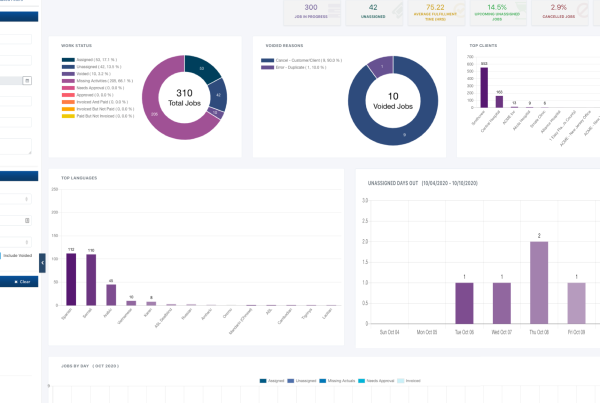The Role of Language Services in a Value-Based Healthcare System
The 2021 “Healthcare Consumerism in a Multilingual Market” Report provides an overview of two main areas:
- The 21st-century trend toward healthcare consumerism and the implementation of value-based care programs
- A market analysis of demographic and immigration trends in the increasingly multilingual healthcare consumer base
The report also examines how the COVID-19 pandemic has accelerated the existing trend towards healthcare consumerism, permanently impacting the healthcare industry, the relationship between patients and providers, and the mediating role of the language services industry.
This two-part blog series will break down each of those main areas, and explore the ways in which they affect our industry as a whole both today and in the future.
The Evolution of 21st Century Healthcare
Shifting to a patient-centric model
The healthcare industry in the United States has undergone a seismic shift in the last decade. The 2010 Affordable Care Act (ACA), changes to Rule 1557 in 2016, along with a mix of external circumstances, free-market incentives, and government directives had already contributed to this shift, but then COVID-19 entered the scene.
The end result has culminated in the healthcare industry’s departure from a fee-for-service (FFS) model toward a new patient-centric model of healthcare consumerism.
The problem with fee-for-service (FFS)
The fee-for-service (FFS) model (in which payment is dependent on the quantity rather than the quality of care) has been operating in the United States since the establishment of Medicare and Medicaid in 1965. However, there is a growing body of evidence showing that the FFS model raises costs and negatively impacts the efficiency of integrated care.
It was for this very reason that the “Centers for Medicare and Medicaid (CMS) initiated three important programs — mandated by the Affordable Care Act — that reward hospitals based on the quality of care provided to patients. They are:
- The Hospital Value-Based Purchasing (VBP) Program initiated in 2012;
- The Hospital Readmission Reduction Program (HRRP) initiated in 2012; and
- The Hospital-Acquired Condition (HAC) Reduction Program initiated in 2014.
The Hospital Value-Based Purchasing Program
The Hospital VBP Program was established in order to reward
“acute care hospitals with incentive payments based on the quality of care they provide, rather than just the quantity of services.”
The quality control measures used include:
- Clinical Outcomes
- Person and Community Engagement
- Safety
- Efficiency and Cost Reduction
The Hospital Readmission Reduction Program
As a Medicare value-based purchasing program, the HRRP strives to incentivize hospitals to strengthen patient-provider communication and care coordination.
The overall goal is “to better engage patients and caregivers in discharge plans, and, in turn, reduce avoidable readmissions”.
Under Section 3025 of the Patient Protection and Affordable Care Act, the Secretary of the US Department of Health and Human Services (HHS) is obligated to establish HRRP and reduce payments to Inpatient Prospective Payment System hospitals for excess readmissions. This readmission data is then collected and analyzed to calculate an Excess Readmission Ratio (ERR). Should hospitals receive an ERR greater than one, they risk losing up to three percent reimbursement for their Medicare patient admissions.
The 21st Century Cures Act
To offset a likelihood that safety-net hospitals (hospitals that care for patients regardless of their insurance status) will be disproportionately penalized, the 21st Century Cures Act requires the CMS to “assess a hospital’s performance relative to other hospitals with a similar proportion of patients who are dually eligible for Medicare and full Medicaid benefits.”
The Hospital Acquired Condition Reduction Program
The HAC Reduction program strives to improve patient safety and reduce the number of negative conditions patients experience from time spent in the hospital (such as pressure sores and infections associated with healthcare). Its overall aim is to encourage hospitals to implement and maintain best practices in patient safety.
“CMS has made a strong commitment to advancing [value based care] VBC in Medicare for its 61.7 million enrollees.”This guidance is designed to ensure that this same commitment can be made at the state level through Medicaid with its nearly 74 million beneficiaries.”
Then along came COVID-19.
The evolution of healthcare consumerism has been accelerated by the COVID-19 pandemic due to an increased interest in telemedicine along with an increased adoption of wearable medical technology, allowing patients and providers to effectively communicate while social distancing.
All of these changes are gradually converging into a new role that the patient is playing in healthcare — no longer the passive recipient of healthcare services but rather the key decision-maker. However, for patients to make informed decisions as healthcare consumers, it is critical for healthcare providers to communicate clearly and effectively in a language that consumers can understand.
Improving Outcomes through Effective Communication — Welcome to Propio
In order for patients to feel empowered, healthcare providers must communicate directly with — and engage — the patient population. Effective communication with patients throughout their medical experience yields tangible benefits including improved health outcomes and lower medical costs. Patient engagement leads to patient empowerment and improved patient care. This is especially important for the limited-English proficient (LEP) patient population that has been traditionally marginalized in the US healthcare system. For that reason, it is imperative to partner with a language service provider (LSP) with specialized knowledge about the Healthcare and Life Sciences industries. Welcome to Propio.
With over 20 years of experience in healthcare language services, Propio has mastered the art and science of connecting healthcare providers to their diverse patient population. We continue to lead the way, ensuring both healthcare practitioners and their patients are heard and understood. We work with a wide range of healthcare providers and offer professional multilingual solutions in over 200 languages. Whether you require in-person, over-the-phone, or remote healthcare interpreting, specialized translation or localization services, we have you covered.









